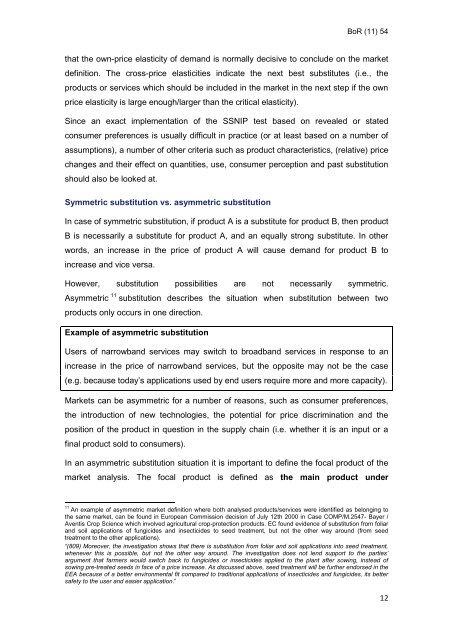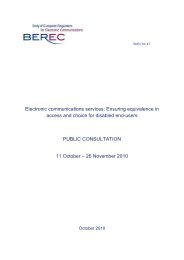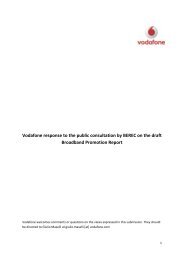BEREC REPORT ON IMPACT OF FIXED-MOBILE ... - berec - Europa
BEREC REPORT ON IMPACT OF FIXED-MOBILE ... - berec - Europa
BEREC REPORT ON IMPACT OF FIXED-MOBILE ... - berec - Europa
You also want an ePaper? Increase the reach of your titles
YUMPU automatically turns print PDFs into web optimized ePapers that Google loves.
BoR (11) 54<br />
that the own-price elasticity of demand is normally decisive to conclude on the market<br />
definition. The cross-price elasticities indicate the next best substitutes (i.e., the<br />
products or services which should be included in the market in the next step if the own<br />
price elasticity is large enough/larger than the critical elasticity).<br />
Since an exact implementation of the SSNIP test based on revealed or stated<br />
consumer preferences is usually difficult in practice (or at least based on a number of<br />
assumptions), a number of other criteria such as product characteristics, (relative) price<br />
changes and their effect on quantities, use, consumer perception and past substitution<br />
should also be looked at.<br />
Symmetric substitution vs. asymmetric substitution<br />
In case of symmetric substitution, if product A is a substitute for product B, then product<br />
B is necessarily a substitute for product A, and an equally strong substitute. In other<br />
words, an increase in the price of product A will cause demand for product B to<br />
increase and vice versa.<br />
However, substitution possibilities are not necessarily symmetric.<br />
Asymmetric 11 substitution describes the situation when substitution between two<br />
products only occurs in one direction.<br />
Example of asymmetric substitution<br />
Users of narrowband services may switch to broadband services in response to an<br />
increase in the price of narrowband services, but the opposite may not be the case<br />
(e.g. because today’s applications used by end users require more and more capacity).<br />
Markets can be asymmetric for a number of reasons, such as consumer preferences,<br />
the introduction of new technologies, the potential for price discrimination and the<br />
position of the product in question in the supply chain (i.e. whether it is an input or a<br />
final product sold to consumers).<br />
In an asymmetric substitution situation it is important to define the focal product of the<br />
market analysis. The focal product is defined as the main product under<br />
11 An example of asymmetric market definition where both analysed products/services were identified as belonging to<br />
the same market, can be found in European Commission decision of July 12th 2000 in Case COMP/M.2547- Bayer /<br />
Aventis Crop Science which involved agricultural crop-protection products. EC found evidence of substitution from foliar<br />
and soil applications of fungicides and insecticides to seed treatment, but not the other way around (from seed<br />
treatment to the other applications).<br />
“(809) Moreover, the investigation shows that there is substitution from foliar and soil applications into seed treatment,<br />
whenever this is possible, but not the other way around. The investigation does not lend support to the parties’<br />
argument that farmers would switch back to fungicides or insecticides applied to the plant after sowing, instead of<br />
sowing pre-treated seeds in face of a price increase. As discussed above, seed treatment will be further endorsed in the<br />
EEA because of a better environmental fit compared to traditional applications of insecticides and fungicides, its better<br />
safety to the user and easier application.”<br />
12





